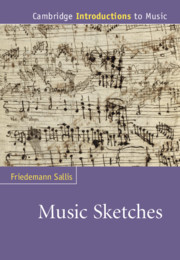Book contents
- Frontmatter
- dedication
- Contents
- List of figures
- List of music examples
- List of tables
- Preface
- Chapter 1 Introduction
- Chapter 2 Sketch studies past and present
- Chapter 3 Tracking down evidence of the creative process
- Chapter 4 The physical objects of the compositional process
- Chapter 5 Studying loose leaves
- Chapter 6 Sketchbooks
- Chapter 7 Transcription and facsimile reproduction
- Chapter 8 Sketches and the critical edition of music
- Chapter 9 Dangerous liaisons: the evolving relationship between sketch studies and analysis
- Chapter 10 Musical palimpsests and authorship
- Appendix: Beethoven sketchbooks published between 1913 and 2013
- Notes
- Glossary
- Bibliography
- Index
Chapter 9 - Dangerous liaisons: the evolving relationship between sketch studies and analysis
Published online by Cambridge University Press: 05 February 2015
- Frontmatter
- dedication
- Contents
- List of figures
- List of music examples
- List of tables
- Preface
- Chapter 1 Introduction
- Chapter 2 Sketch studies past and present
- Chapter 3 Tracking down evidence of the creative process
- Chapter 4 The physical objects of the compositional process
- Chapter 5 Studying loose leaves
- Chapter 6 Sketchbooks
- Chapter 7 Transcription and facsimile reproduction
- Chapter 8 Sketches and the critical edition of music
- Chapter 9 Dangerous liaisons: the evolving relationship between sketch studies and analysis
- Chapter 10 Musical palimpsests and authorship
- Appendix: Beethoven sketchbooks published between 1913 and 2013
- Notes
- Glossary
- Bibliography
- Index
Summary
The problem and its context
From the late-nineteenth century onwards, the value of composers’ sketches for the study and interpretation of music has been much discussed. For some this is a non-issue. A recent textbook intended to introduce first-year undergraduates to the study of music baldly states that the composer’s surviving working documents ‘can only rarely tell us much about the finished piece’. Others disagree. In Nicolas Marston’s view, asking what kind of relationship may or may not exist between sketch studies and analysis, or between the genesis of a work of art and its structure means facing up to ‘dangerous liaisons’ that are ‘apt to bring complex theoretical issues into play, which in the present context, can hardly be shunned’. Marston’s position is reinforced by a large body of work that has been accumulating over the past half century.
The classic example is William Kinderman’s analysis of the Diabelli Variations, Op. 120. He observed that after having conceived approximately two-thirds of the work, Beethoven set it aside in 1819, completing it in 1823. The later phase of composition entailed a significant alteration of the initial formal plan. In Kinderman’s opinion, the unique solution to the artistic problems Beethoven was confronting cannot be clearly understood without recourse to the sketches and drafts. In the field of twentieth-century studies Christoph Neidhöfer’s examination of the genesis of Bruno Maderna’s Quartetto per archi in due tempi (1955) provides another example. Through his careful study of sketches preserved at the Paul Sacher Foundation, Neidhöfer was able to identify and analyse the objective and subjective aspects of Maderna’s compositional technique: that is to say, serial technique and the composer’s intuitive manipulations of it. Without knowledge of both sides of the creative process, a thorough analysis of the completed work would be impossible.
- Type
- Chapter
- Information
- Music Sketches , pp. 161 - 176Publisher: Cambridge University PressPrint publication year: 2015

